
319-320 in Wheaton. (Mark Llanuza Collection)
Thanks to the generosity of Mark Llanuza, we are today featuring photos from his collection that were taken on December 7, 1958, on the final passenger movement on the Chicago, Aurora & Elgin interurban. This was a fantrip sponsored by the Illini Railroad Club.
As you can see in the flyer reproduced below, the trip started and ended at 5th Avenue in Maywood. This was as far east as CA&E could go in 1958. To get there from the DesPlaines Avenue CTA terminal, fans would have taken the CTA #17 bus (which replaced the Westchester “L” in 1951), got off at Madison and First, and walked about three blocks south.
In a previous post (“The CTA, the CA&E, and “Political Influence,” Feb. 18, 2015) we delved into some of the issues surrounding efforts to save the CA&E, and why they ultimately failed.
In short, CA&E was allowed to “temporarily” abandon passenger service as of July 3, 1957 because, at that moment, it was in the best interests of all the various power brokers who were involved.
The State of Illinois wanted very much to begin expressway construction near the DesPlaines River, so that two segments of highway could be connected. CA&E owned a crucial piece of property where the highway was to be built, and if they had not agreed to sell it, this could have held up construction for two years.
CA&E, in turn, had been operating at a loss since they voluntarily stopped running their trains over CTA trackage in September 1953. They had received a lot of income, on the other hand, through the sale of various parts of their right-of-way. For example, the CTA bought CA&E’s infrastructure between Laramie and DesPlaines Avenue (but not, apparently, the terminal itself) for $1m. Instead of using this money to purchase new equipment, the railroad distributed the proceeds from this partial liquidation to their shareholders.
These kinds of actions invited speculators to purchase CA&E stock and helped hasten the eventual liquidation of the entire railroad. It was worth more dead than alive. Operating, it lost money, but liquidated, it meant a handsome profit to the shareholders.

A CA&E stock certificate issued in 1956 to Curtis M. Wylie (1890-1958), a Michigan businessman. The stock was redeemed in 1959 after his death. Wylie left a bequest of $6.2m to the Grand Rapids Foundation, which continues to benefit the community today.
If CA&E had wanted to continue operating passenger service, it would have been possible to build a temporary track connection with the CTA Forest Park terminal via the Chicago Great Western starting at First Avenue using overhead wire. But CA&E was only interested in either selling the entire railroad (to the State or the CTA) or liquidating it. The highway project became an expedient excuse for abandonment. Meanwhile, CA&E insisted on being reimbursed for the operating losses they had incurred since 1953, and this appears to have been folded into the amount they were paid for their right-of-way between First Avenue and DesPlaines.
There were, in fact, additional portions of CA&E right-of-way that were needed for highway construction elsewhere. In retrospect, it would have saved the state money if they had simply purchased the entire railroad for $6m, as they nearly did in 1956. But this would have made the state responsible for maintaining service.
Likewise, it did not benefit the CTA to keep the CA&E running. Better to let them abandon service, in case it would have been possible for the CTA to resume service over a portion of the interurban (to Wheaton) later on. In any event, CTA did not want to operate any service over former CA&E trackage until and unless their additional operating expenses would be paid for. And nobody stepped forward to make that happen.
So, once CA&E had distributed the proceeds from various land sales to their shareholders, there was little or nothing left in the till to pay for a resumption of passenger service in 1959. And although there was a modest increase in freight traffic after the 1957 abandonment of passenger service, the railroad was still losing money. Without a firm sale or an additional funding source, the railroad’s choices were to either dissipate all their remaining assets, or simply go out of business.
It was hoped that the December 1958 fantrip would help generate interest in a resumption of passenger service on the CA&E. Unfortunately, this did not happen.
If service had been resumed, there likely would have been continued short-term losses in passengers due to completion of the Congress (now Eisenhower) expressway in the suburbs. But over time, this trend surely would have reversed itself and passenger counts would have once again increased as the western suburbs became more and more built up.
As it turned out, the state and CTA wanted to be the “good cops,” who would resume some partial level of service on the interurban if DuPage County would cover the costs, and were perfectly happy to let CA&E act as the “bad cop” who discontinued service. And in this, they rose to the occasion, with an abrupt midday shutdown that stranded thousands of riders on July 3, 1957. They were content to “take the money and run,” so to speak.
The great majority of images in this post were shot by one unknown photographer who went on the 1959 fantrip. Mark Llanuza purchased them from the man’s daughter after he died.
Film speeds were much slower in 1958 than they are today. Kodachrome was ISO 10, meaning it was mainly usable only on sunny days. However, Kodak had also introduced Ektachrome, another slide film with an initial speed of 32. I believe this is the film used on that day.
These images have a larger grain structure than is typical for Kodachrome, and are, in general, underexposed. This was a day when ISO 400 would have been a better choice, if such a thing had existed. Even the most popular black-and-white film of the time, Super-XX, only had a speed of 200 ISO.
Many railfan photographers were turned off to Ektachrome because the version available around 1956 faded badly to red in a short period of time. (Technically speaking, the red layer stayed the same, while the green and blue layers faded.) This problem appears to have been solved by 1958, when these pictures were taken.
Under the circumstances, we can be glad that the pictures turned out as well as they did. Since the film was somewhat underexposed, there are reciprocity shifts in color, which generally gave these images an overall blue cast which is unnatural. We have attempted to correct for these color shifts as best we could, but it was not always possible to eliminate all of them without increasing the contrast in each image to an excessive degree. In other words, if there is snow in the picture, you want the snow to look white and not blue, yellow, or gray.
Looking at these pictures, it’s possible to figure out somewhat the itinerary for the trip, including the photo stops and where there were staged run-bys for the benefit of motion picture cameras. Presumably, if there weren’t any freight movements on that Sunday, the fantrip had the entire railroad to itself and didn’t have to worry about any meets.
The flyer mentions a “speed run” back from Elgin but I do not know offhand to what extent CA&E’s automatic gates were still in use at this point. Freight service continued for but a few more months after this before it, too, was abandoned forever.
Thanks again to Mark for sharing these rare images with us, the last gasp of the legendary “Roarin’ Elgin.”
-David Sadowski
PS- You can hear rare audio recordings of the Chicago, Aurora & Elgin on Railroad Record Club LP #36. This recording has been digitally remastered onto compact disc, along with RRC 35, and is available in our Online Store. Along with the CA&E, this disc also features recordings of the CTA Garfield Park “L”, the North Shore Line, and Milwaukee city streetcars.
Mark Llanuza writes:
You did a really great job putting this together for your fans and members. I talked to Norm Carlson who rode this trip on a very cold December 7th 1958 trip. He said it was cold and damp, then started to rain and got colder and snow came. They ran five photo run bys– one at Elgin station, Lakewood, Wheaton Golf club, Price Crossing rd., Glen Oak, and a grand tour of the Wheaton shops in the snow storm.
Help Support The Trolley Dodger
This is our 114th post, and we are gradually creating a body of work and an online resource for the benefit of all railfans, everywhere. To date, we have received over 116,000 page views, for which we are very grateful.
You can help us continue our original transit research by checking out the fine products in our Online Store. You can make a donation there as well.
As we have said before, “If you buy here, we will be here.”
We thank you for your support.
http://www.greatthirdrail.org/images/ROW_despl_br.jpg
When the fantrip took place, the CA&E’s former right-of-way near the DesPlaines River was torn up for expressway construction. As you can see in this photo, the bridge was in the process of being shifted to the north, with a new track alignment. This process was not completed until the second half of 1959, by which time the railroad was unable to resume service even on a trial basis. The new track connection to the CTA Forest Park terminal was never used.

The Chicago Tribune weather forecast for December 7, 1958 called for cloudy and cold conditions, with a temperature between 12 and 20 degrees.

The flyer for what became the final passenger movement on the CA&E. Freight service lasted a few months into 1959 before it too was abandoned. Various efforts to revive the interurban failed, and it received government permission for complete abandonment in 1961. (William Barber Collection)

A CA&E pocket map made by Roy G. Benedict in 1958, when the “Roarin’ Elgin” had already abandoned passenger service (except for charters) but was still running freight. Roy mimeographed these and sold them to aspiring railfans. He has made many additional maps since, and has had a successful career in the publishing industry.
When the fantrip began at 10:00 am, it had not started snowing yet. By the time it ended, at 5:00 pm, a substantial amount of snow was on the ground.

On December 7, 1958, CA&E wood cars 319 and 320 operated the last passenger train on that venerable railroad as a charter. Here, we are at Fifth Avenue station looking east. After the CTA abandoned the Westchester branch, this station was repainted in CA&E colors, and the interurban took over all service here from 1951-57.

319-320 at the Aurora terminal. (Mark Llanuza Collection)

Aurora terminal. (Mark Llanuza Collection)
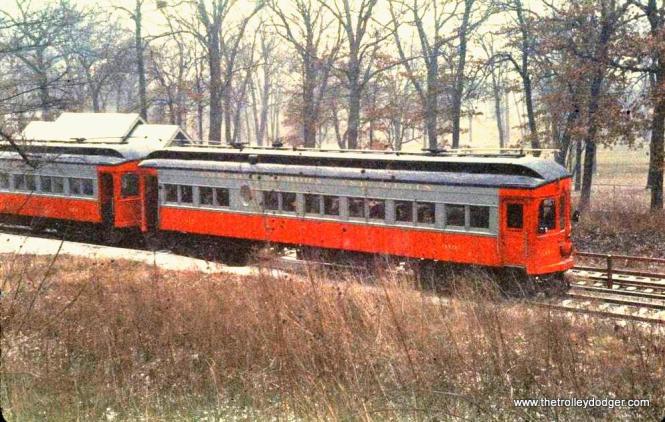
319-320 at Glen Oak. (Mark Llanuza Collection)
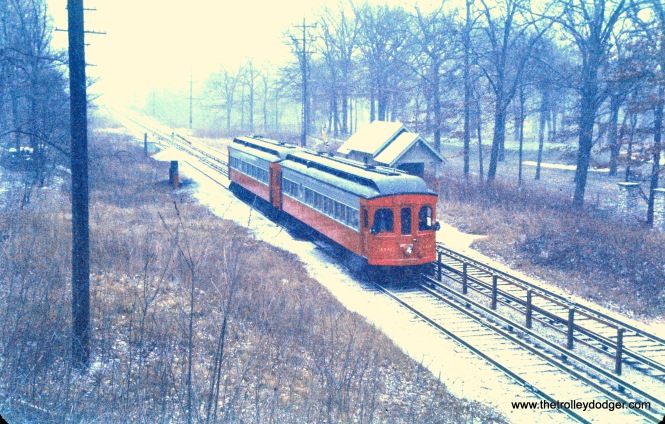
319-320 at Glen Oak. (Mark Llanuza Collection)
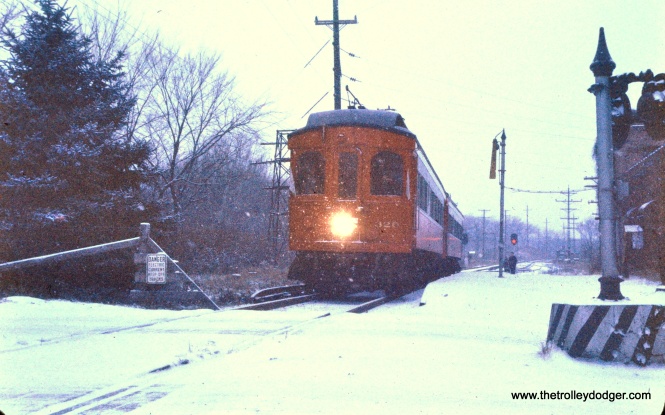
320-319 at Prince Crossing on the Elgin branch. (Mark Llanuza Collection)
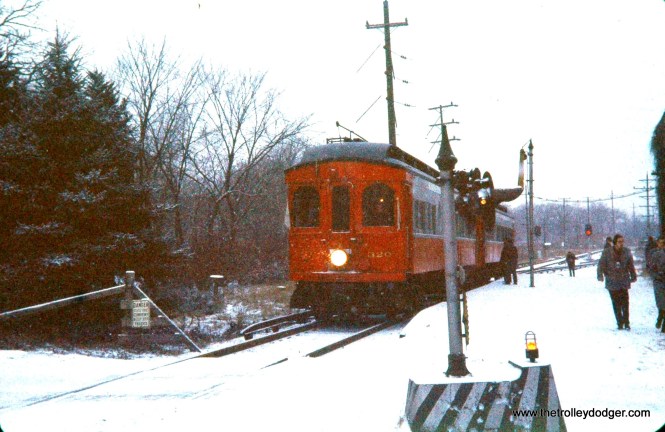
320-319 at Prince Crossing Road. (Mark Llanuza Collection)

Chicago Golf Club at Wheaton. (Mark Llanuza Collection)

319-320 at the Chicago Golf Club in Wheaton. (Mark Llanuza Collection)

319 at Wheaton Shops. (Mark Llanuza Collection)

Freight motors at Wheaton Shops. (Mark Llanuza Collection)

Wheaton Shops. (Mark Llanuza Collection)

Wheaton Shops. (Mark Llanuza Collection)
![Wheaton Shops. (Mark Llanuza Collection)[/caption]](https://oldhomeweek.files.wordpress.com/2016/01/chicago-aurora-elgin-last-tour-wheaton-frt-shops-dec-1958.jpg?resize=665%2C420)
Wheaton Shops. (Mark Llanuza Collection)
![Wheaton Shops. (Mark Llanuza Collection)[/caption]](https://oldhomeweek.files.wordpress.com/2016/01/chicago-aurora-elgin-last-tour-of-wheaton-shops-1958.jpg?resize=665%2C421)
Wheaton Shops. (Mark Llanuza Collection)
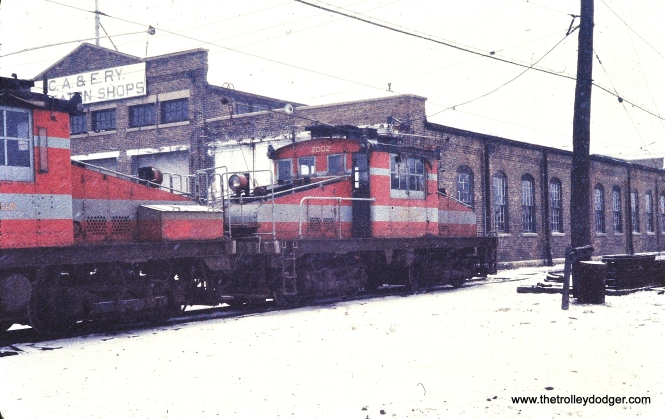
Wheaton Shops. (Mark Llanuza Collection)
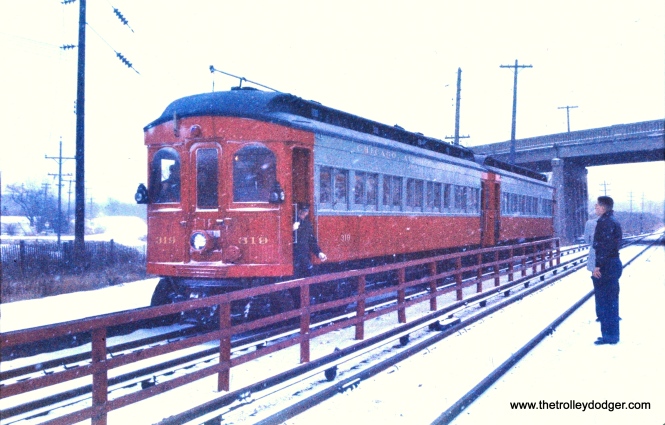
319-320 at Lakewood Station in West Chicago. (Mark Llanuza Collection)

The former Lakewood station as it looked last summer. It is now part of the Illinois Prairie Path. (Mark Llanuza Photo)

At speed near Lakewood Station, West Chicago. (Mark Llanuza Collection)

319-320 near the Clintonville Station on the Elgin branch, December 7, 1958. (Mark Llanuza Collection)

319-320 in Elgin. (Mark Llanuza Collection)
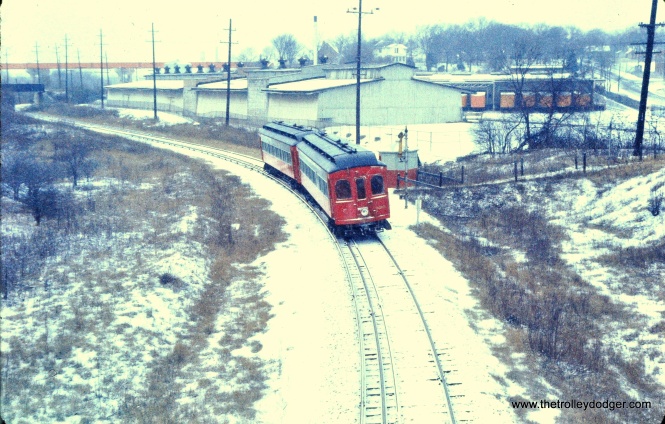
At the Corrugated Box Co., Elgin. (Mark Llanuza Collection)
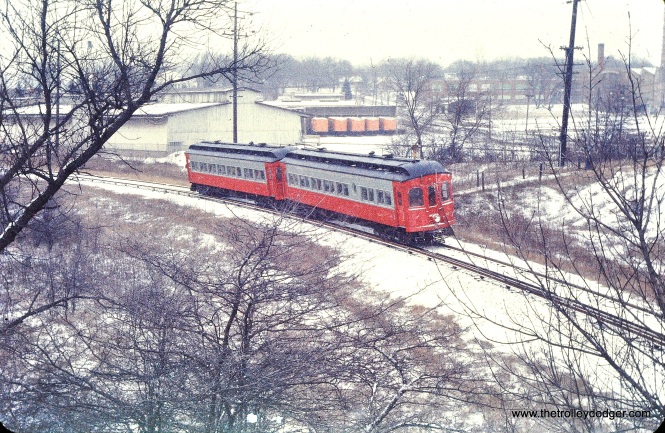
At the Corrugated Box Co., Elgin. (Mark Llanuza Collection)
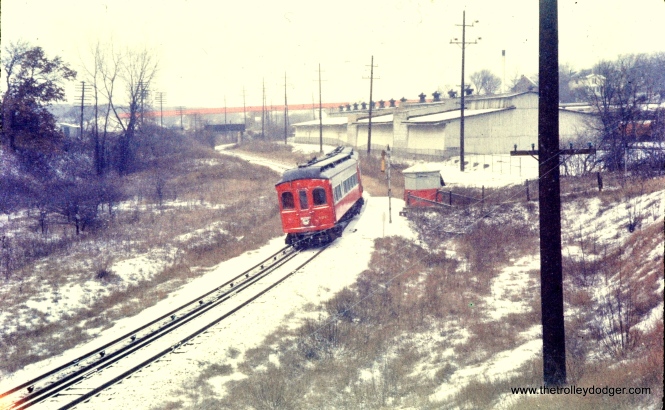
At the Corrugated Box Co., Elgin. (Mark Llanuza Collection)

320-319 near the Corrugated Box Company on the Elgin branch, December 7, 1958. (Mark Llanuza Collection)

320-319 at the Elgin terminal. (Mark Llanuza Collection)

320 at the Elgin terminal. (Mark Llanuza Collection)
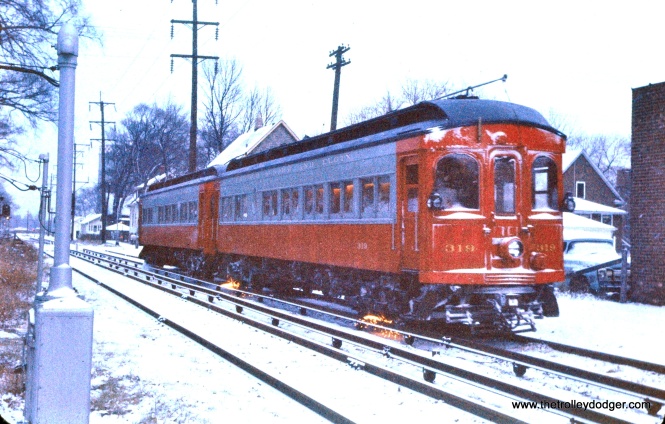
319-320 arcing in Maywood. (Mark Llanuza Collection)
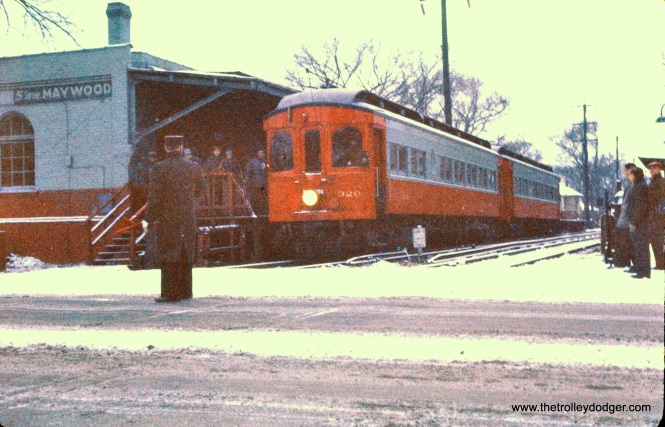
320-319 at 5th Avenue, Maywood. (Mark Llanuza Collection)
After Abandonment:

Dunham Road, Wayne IL, January 1960. (Mark Llanuza Collection)

Dunham Road, Wayne IL, January 1960. (Mark Llanuza Collection)
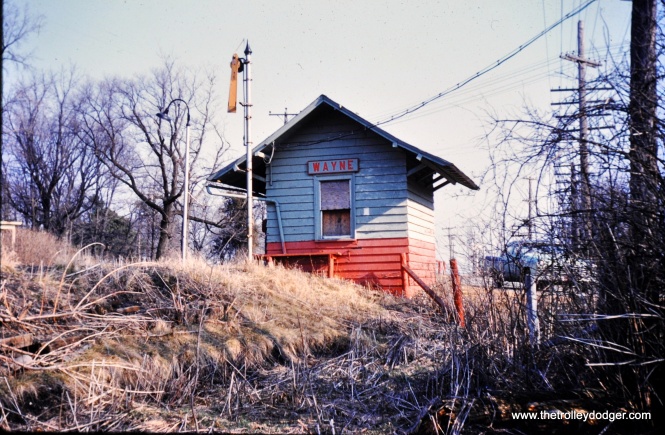
The former CA&E station at Wayne (Army Trail Road) as it looked in November 1961. (Mark Llanuza Collection)

Glen Ellyn Station in 1961. (Mark Llanuza Collection)
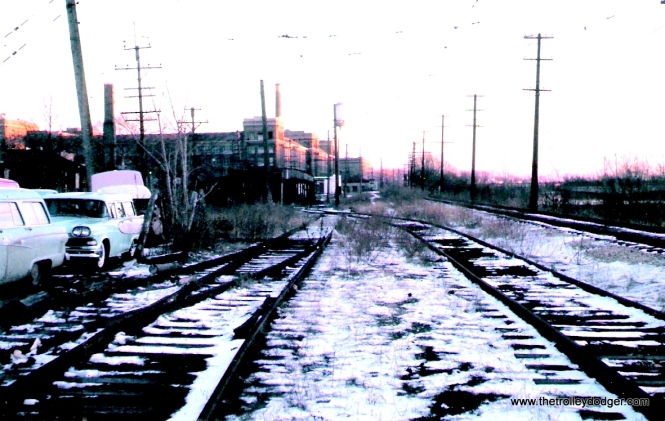
The Elgin Watch Factory in January 1963. It closed the following year. (Mark Llanuza Collection)




Where are the pictures of Glen Ellyn taken, the ones after Glen Oak? Are those Taylor ave?
A couple of these images were misidentified when I got them. The ones that you mention were actually taken in Wheaton at the Chicago Golf Club.
I can’t recall ever seeing so many CA&E color pictures taken in the snow in one place before. Many have the dreamy quality of a Christmas card. The flag stop at Dunham Road was identified as “St. Charles Road” in the timetable, and Corrugated Box Company was “Collingbourne” in the timetable, after long-gone Collingbourne Mills.
Oh, and paper stock certificates? Haven’t they gone the way those writing machines called “typewriters”? A truly enjoyable set of pictures.
Thanks! A few locations have now been corrected as well.
Are the CGW tracks still being used?
Nope. Abandoned around 1969 as I recall. They connected with the B&OCT just north of the CTA station in Forest Park. The section east of First Avenue has been turned into, more or less, an eastern extension of the Prairie Path. It even has its own bridge over the Des Plaines River.
This was awesome thank you for sharing wish my friend could have seen this
[…] images, reproduced below. The ones from the final fantrip have also been added to our previous post A Cold Last Ride (January 25, 2016). We thank him for his generosity in sharing them with our […]
I moved to Wheaton in 1955 about 4 blocks from the Shops. My Mom would take me on the train downtown and to visit family in the city. I was pretty small but remember the sights and sounds of the cars. After the closure, we used to roam the yards and old buildings at the shops. It was a treasure hunt every time. Several years ago I still saw evidence of a track siding in the gravel parking lot at what used to be Wallfill’s on Childs Street next to the line heading toward Chicago Golf Club. Great photos and memories.
[…] Contrast this with pictures of the same station in the interurban’s waning days, in our post A Cold Last Ride (January 25, 2016). The postcard itself was printed by William G. Hoffman of 4340 Jackson Boulevard […]